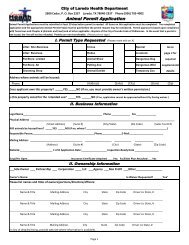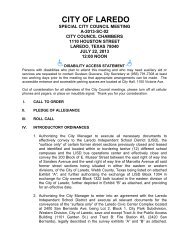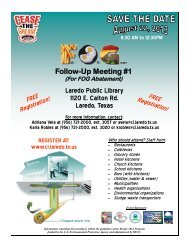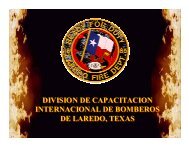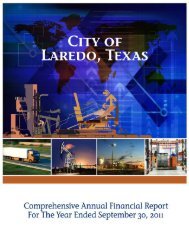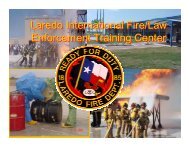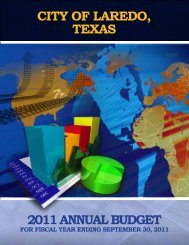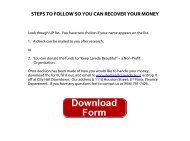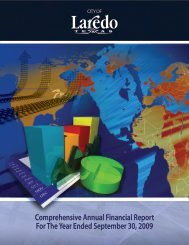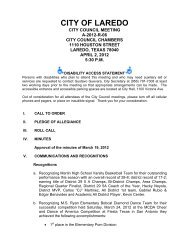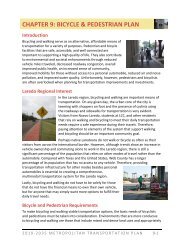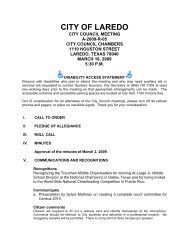- Page 1 and 2:
CITY OF LAREDO CITY COUNCIL MEETING
- Page 3 and 4:
25-6 International Fuel Gas Code, t
- Page 5 and 6:
9. Public hearing and introductory
- Page 7 and 8:
All being situated in the Eastern D
- Page 9 and 10:
0922-33-109 (1.0 miles south of SH
- Page 11 and 12:
assurance for the Laredo Internatio
- Page 13 and 14:
XIII. STAFF REPORTS 4. Presentation
- Page 15 and 16:
COUNCIL COMMUNICATION DATE: I SUBJE
- Page 17 and 18:
ORDINANCE AUTHORIZING THE CITY MANA
- Page 19 and 20:
DATE: COUNCIL COMMUNICATION SUBJECT
- Page 21 and 22:
PASSED BY THE CITY COUNCIL AND APPR
- Page 23 and 24:
AN ORDINANCE ACCEPTING A GRANT FROM
- Page 25 and 26:
COUNCIL COMMUNICATION DATE: SUBJECT
- Page 27 and 28:
PASSED BY THE CITY COUNCIL AND APPR
- Page 29 and 30:
ORDINANCE NO. AMENDING CHAPTER 11 E
- Page 31 and 32: Date: 10-15-2012 INITIATED BY: COUN
- Page 33 and 34: Section 5. That this Ordinance and
- Page 35 and 36: BACKGROUND: The Fire Chief with con
- Page 37 and 38: WHEREAS, on January 4, 2010, by Ord
- Page 39 and 40: DATE 10-15-12 INITIATED BY: Horacio
- Page 41 and 42: Part 1: Section 7-1. Code-Adopted.
- Page 43 and 44: Date: 10/15/12 Initiated by: Cornel
- Page 45 and 46: CITY OF LAREDO ORDINANCE NO. 2012-0
- Page 47: UNPLATTED
- Page 52 and 53: 1 t Warranty: Because the condition
- Page 54 and 55: INGREDIENT: NONE SECTION 2 - HAZARD
- Page 56 and 57: INHALATION: REMOVE TO FRESH AIR HOW
- Page 58 and 59: , K+M:[C;N.. PR3i:XJI."I' and LTMI:
- Page 60 and 61: d%ath. I ly c1vvnj.c exposure of an
- Page 62 and 63: IR'T MMHF:R: 'W HIM, INT. R4I-E: 00
- Page 64 and 65: ndar has adop.t~J the ACIXIH R.Ui r
- Page 66 and 67: R'T MMER: 703 WPM (EA IK, NQI tK!14
- Page 68 and 69: WPAK I.&> IK- PAGE: 011. MEPI~L ?E&
- Page 70 and 71: 1 DR1' MMFn:H : 7!)3 w)~-%u! IN::.
- Page 72 and 73: PRODUCT NAME: CHEMICAL NAME: I - CH
- Page 74 and 75: I PAGE 3 PRODUCT NAME: '[RIETHYLENE
- Page 76 and 77: HP~~ARDous POLYMERI~ATI~N: wlil Not
- Page 78 and 79: PRODUCT NAME: ITRIFTHYLENE GLYCOL i
- Page 80 and 81: Material Safety Data Sheet ~ I 1 I
- Page 84 and 85: Material SafetylData Sheet Acute Or
- Page 86 and 87: Material Safety1 Data Sheet Shell H
- Page 88 and 89: Material Safety i)ata Sheet , Shell
- Page 90 and 91: Material Safety Qata Sheet I / Shel
- Page 92 and 93: Material Safety; Data Sheet Shell R
- Page 94 and 95: Material Safety Data Sheet Equipmen
- Page 96 and 97: I Material Safety,Data Sheet Shell
- Page 98 and 99: I Material Safely Data Sheet Shell
- Page 100 and 101: STAFF COMMENTS (CONTINUED) COUNCIL
- Page 102 and 103: hereof for all purposes. 4. All mer
- Page 104 and 105: 1020 Santa Maria Ave Council Distri
- Page 106: .. oi CO . d- oi CO 0 - Washington
- Page 111 and 112: STAFF COMMENTS (CONTINUED) COUNCIL
- Page 113 and 114: 3. The C.U.P. is restricted to the
- Page 115 and 116: UNPLATTED J*s=specia~ Use Permit (S
- Page 117: WATER ST. WATER ST. VBNTURA ST.
- Page 122 and 123: INTRODUCTORY ORDINANCE Ratifying th
- Page 124 and 125: CP 460-OWUG (CORPORATION) REV. 05/1
- Page 126 and 127: LAREDO, mxhS 1755 EXHIBIT "Av PAGE
- Page 128 and 129: DATE: 10/15/2012 INITIATED BY: Carl
- Page 130 and 131: delivery of Acceptance Certificates
- Page 132 and 133:
EQUIPMENT LEASEIPURCHASE AGREEMENT
- Page 134 and 135:
"Renewal Terms" means the renewal t
- Page 136 and 137:
(1) No lease, rental agreement, lea
- Page 138 and 139:
103 of the Code. In furtherance of
- Page 140 and 141:
(vi) All documents, including finan
- Page 142 and 143:
een delivered and installed, Lessee
- Page 144 and 145:
all utility and other charges incur
- Page 146 and 147:
level of energy and/or operational
- Page 148 and 149:
transfer or conveyance to a trustee
- Page 150 and 151:
(f) An order, judgment or decree sh
- Page 152 and 153:
IN WITNESS WHEREOF, Lessor and Less
- Page 154 and 155:
Contract Rate. The Contract Rate is
- Page 156 and 157:
Agreement (including such Exhibits)
- Page 158 and 159:
FORM OF INCUMBENCY AND AUTHORIZATIO
- Page 160 and 161:
3. The Transaction Documents have b
- Page 162 and 163:
Banc of America Public Capital Corp
- Page 165 and 166:
FORM OF NOTICE AND ACKNOWLEDGEMENT
- Page 167 and 168:
EXHIBIT I Form of Acquisition Fund
- Page 169 and 170:
with any Event of Default under the
- Page 171 and 172:
notice of any security interest in
- Page 173 and 174:
In Witness Whereof, the parties hav
- Page 175 and 176:
(iii) This requisition contains no
- Page 177 and 178:
COUNCIL COMMUNICATION DATE: SUBJECT
- Page 179 and 180:
BUDGET AMENDMENT OF NOISE ABATEMENT
- Page 181 and 182:
ORDINANCE NO. 2012-0-174 AMENDING T
- Page 183 and 184:
DATE: COUNCIL COMMUNICATION SUBJECT
- Page 185 and 186:
ORDINANCE 2012-0-175 AUTHORIZING TH
- Page 187 and 188:
COUNCIL COMMUNICATION I DATE: / SUB
- Page 189 and 190:
ATTEST: Section 2: It hereby author
- Page 191 and 192:
RESOLUTION #2012-R-087 Amending res
- Page 193 and 194:
LAREDO POLICE DEPARTMENT Agreements
- Page 195 and 196:
GM200113 Fiscal Year 2013 Account n
- Page 197 and 198:
DATE: 10- 15- 12 SUBJECT: MOTION CO
- Page 199 and 200:
GM200113 CITY OF LAREDO Fiscal Year
- Page 201 and 202:
DATE: 10- 15- 12 COUNCIL COMMUNICAT
- Page 203:
DATE: 10/15/12 INITIATED BY: Carlos
- Page 207 and 208:
DATE: 10/15/2012 INITIATED BY: HORA
- Page 209 and 210:
PREPARED 9/28/12, 18:21:40 TAX ADJU
- Page 211 and 212:
PREPARED 9/28/12, 18:21:40 TAX ADJU
- Page 213 and 214:
PREPARED 9/28/12, 18:21:40 PROGRAM
- Page 215 and 216:
PREPARED 9/28/12, 17:33:06 TAX PERI
- Page 217 and 218:
DATE: 3ctober 15,2012 INITIATED BY:
- Page 219 and 220:
RESOLUTION NO. 2012-R-083 PASSED BY
- Page 221 and 222:
County WEBB District Laredo (22) RO
- Page 223 and 224:
County: Webb District: Laredo AGREE
- Page 225 and 226:
LOCATION "B" = 1-1 SCALE: 1 = 300'
- Page 227 and 228:
WESOLUTION NO. 20%-R4$9 PASSER BY T
- Page 229 and 230:
-&&q-, . -&:k%- Form ROW-W-EDC Xev.
- Page 232 and 233:
AU'PpQOMZING THE CITY MANAGER TO EX
- Page 234 and 235:
HIGHWAY PROJECT CUATRO VIENTOS ENTI
- Page 236 and 237:
RESOLUTION 201 2-R-086 Authorizing
- Page 238 and 239:
DATE: COUNCIL COMMUNICATION 1 SUBJE
- Page 240 and 241:
DATE: 10115/2012 INITIATED BY: Jesu
- Page 242 and 243:
This Agreement is entered into purs
- Page 244 and 245:
provided the non-performing party e
- Page 246 and 247:
Grantee shall maintain and retain s
- Page 248 and 249:
This Agreement contains the entire
- Page 250 and 251:
QUOTE# 001 CONTRACT PRICING WORKSHE
- Page 252 and 253:
DATE: 10/15/2012 INITIATED BY: Jesu
- Page 254 and 255:
F Non- Equipment Charges (Trade- In
- Page 257 and 258:
DATE: 10/15/12 INITIATED BY: Carlos
- Page 260 and 261:
To: The City of Laredo, Texas Honor
- Page 262 and 263:
Item No, 2 3 4 5 6 Eslimated Quanti
- Page 264 and 265:
Proposed Progress Schedules: +J, E
- Page 266 and 267:
Western Surety Company POWER OF ATT
- Page 268 and 269:
CDBG Sidewalks Project No.43 (25.5
- Page 270 and 271:
DATE: 10/15/12 INITIATED BY: Carlos
- Page 273 and 274:
LLC CDBG SIDEWALKS PROJECT #42 - 23
- Page 275 and 276:
Itiformation to Contractors Page 2
- Page 277 and 278:
STATEMENT OF !#iMTIEIIRI[&S AND OTm
- Page 279 and 280:
Proposal Page 2 of 9 AFFIDAVIT Form
- Page 281 and 282:
Proposal CITY OF LAREDO CDBG SIDEWA
- Page 283 and 284:
Proposal Page 6 of 9 Cumnt Worldoad
- Page 285 and 286:
BID BOND KNOW ALL MEN BY THESE PRES
- Page 287 and 288:
SureTec lnsurance Company THIS BOND
- Page 289 and 290:
SureTec Insurance Company LIMITED P
- Page 291 and 292:
2016 Mcdonell Laredo Tx. 78040 CURR
- Page 293 and 294:
San Luis Rio Colorado, Son. July 19
- Page 295 and 296:
Jacaman Road JUAN RAMIREZ INVESTMEN
- Page 297:
The bid and bid bonds for Leyendeck
- Page 300 and 301:
Affirmative Action Program: Project
- Page 302 and 303:
INFORMATION FROM BIDDERS MUST BE CO
- Page 305 and 306:
TELEPI-IONE (956)-722-053 1 FAX (95
- Page 307 and 308:
TOTAL BASE BID TOTAL BASE BID BID S
- Page 309 and 310:
1 RESTRICTIONS ON LOBBYING CERTIFIC
- Page 311 and 312:
POWER OF ATTORNEY Farnlington Casua
- Page 313:
DATE: 1011 5/12 COUNCIL COMMUNICATI
- Page 317:
DATE: 10/15/12 INITIATED BY: Carlos
- Page 321 and 322:
DATE: 10115112 INITIATED BY: Jesus
- Page 323 and 324:
Bid Tabulation FY 12-097 Contract L
- Page 325 and 326:
DATE: 10/15/12 COUNCIL COMMUNICATIO
- Page 327 and 328:
Requested by: Approved by: Approved
- Page 329 and 330:
September 20,201 2 DANNENBAUM ENGIN
- Page 331 and 332:
additional services and is based on
- Page 333 and 334:
EXHIBIT NO. 1-1 REPLACEMENT PAGE AN
- Page 335 and 336:
ATTACHMENT "A" Replacement Page (mo
- Page 337 and 338:
Date: May 3, 2012 Replacement Page
- Page 339 and 340:
ATTACHMENT "D" Replacement Page LIS
- Page 341 and 342:
Date: Mav , 3.2012 - ATTACHMENT "B"
- Page 343 and 344:
EXHIBIT NO. 2-1 Supplemental No. 1
- Page 345 and 346:
DATE: 1 1/05/2012 COUNCIL COMMUNICA
- Page 347 and 348:
To: Mr. Dan Migura Human Resources
- Page 349 and 350:
07/15/2011- Lt. Ramon had an MRI of
- Page 351 and 352:
Employee . . . . . . . . Authorized
- Page 353 and 354:
Date of Iniury: 10/14/2011 Iniuw: C
- Page 355 and 356:
CITY OF LAREDO Employee Status Info
- Page 357 and 358:
Date of Iniury: 0512 1/20 1 1 Injur
- Page 359:
Employee . . . . . . . . Authorized



